Ijraset Journal For Research in Applied Science and Engineering Technology
- Home / Ijraset
- On This Page
- Abstract
- Introduction
- Conclusion
- References
- Copyright
Control and Monitoring of Electrical Vehicle and Motor
Authors: Dr. S. S. Kadlag, Shembade Shrikrushna, Udar Ashutosh, Sinare Rohan, Phapale Akshay
DOI Link: https://doi.org/10.22214/ijraset.2023.52495
Certificate: View Certificate
Abstract
EV, the major problem that occurs is the burning of EV. After burning of the EV there are no data available for analysis, for that purpose we have proposed a system to address this issue. Inside that, we use different sensors to collect data such as temperature, voltage, current, humidity of motor and battery. Also, from the safety point of a view we have used GSM Module, GPS module, Flex sensor and LDR sensor. Which will help to find the exact location of an accident and provide emergency service.
Introduction
I. INTRODUCTION
Every year, more than a million people worldwide die from transportation-related accidents, according to the World Health Organization. To address this problem, the black box system was developed as the first step in improving road safety across national boundaries [1].
While the black box system was first introduced to a portion of the United States market in 1999, it has since proven to be an efficient tool for investigating accidents and helping insurance companies with their investigations [2]. Black box technology, similar to the flight data recorders used in aircraft, is now increasingly used in motor vehicle crash investigations [3].
Many vehicles already contain electronic systems that record information during a crash, making it important to have objective recordings of what happens before, during, and after the event to complement subjective inputs such as eyewitness accounts and police reports [4]. The black box system has two main approaches: detecting and recording data from the vehicle, and presenting the recorded data to the user in a simplified way [5].
To detect and record data, major components and different types of sensors are used [6]. To present the data, a Visual Basic. Embedded C computer program is used to receive the data serially from the black box memory, display it in real-time graphics, and save it to a formal excel report for future use [7]. In addition to improving treatment for crash victims and road conditions, constructing safer vehicles, and aiding in accident investigations, the development of a black box system that can be installed in any vehicle worldwide can greatly improve road safety [8].
II. PROBLEM STATEMENT
As the adoption of electric vehicles and motors continues to grow, the need for effective control and monitoring systems becomes increasingly critical. However, the implementation of such systems presents emerging challenges, including the need for improved battery management systems to address issues such as range anxiety and battery degradation [9]. Additionally, the use of advanced power electronics and sensors raises concerns regarding their reliability and cybersecurity. This paper explores these emerging problems and proposes potential solutions for ensuring the efficient and safe operation of electric vehicles and motors [10].
III. LITERATURE SURVEY
- Automobiles based black-box system using IoT S. Monika VOLUME: 08 ISSUE: 04 | APR 2021. The black-box system, derived from the aviation industry, is an electronic recording device used in aircraft for investigating aviation accidents and incidents. Our project aims to create a similar device for automobiles using IoT technology. This device will not only aid in post-crash analysis but also in quickening emergency rescue operations. Our research is focused on developing an integrated system for emergency rescue services following a road accident. The device will be cost-effective, and with the help of GPS technology, it will determine the accident location and send it via the internet to a pre-programmed emergency number. This will significantly reduce the response time of emergency rescue teams.
- A Black Box with SMS Alert for Road Vehicles Ranjitha S L NCESC - 2018 Conference Proceedings The concept of the Black Box, derived from the aviation industry, is an electronic device used in aircraft for recording flight data to aid in investigating accidents and incidents. Our project aims to create a similar device for road vehicles, which will not only aid in post-crash analysis but also in quickening emergency rescue operations. Our research is focused on developing an integrated system for emergency rescue services following a road accident. The system uses a GPS module to determine the accident location and a GSM module to send the location via message to a pre-programmed number. This device is installed in the vehicle and will significantly reduce the response time of emergency rescue teams.
IV. EXISTING SYSTEM
There are various proposed solutions to address the problem at hand, each with its unique advantages. One current solution is the implementation of a tracking system in vehicles to prevent accidents and preserve human life. This system utilizes a microcontroller. However, such monitoring systems are only present in high-end vehicles due to their costliness [10].
V. BLOCK DIAGRAM
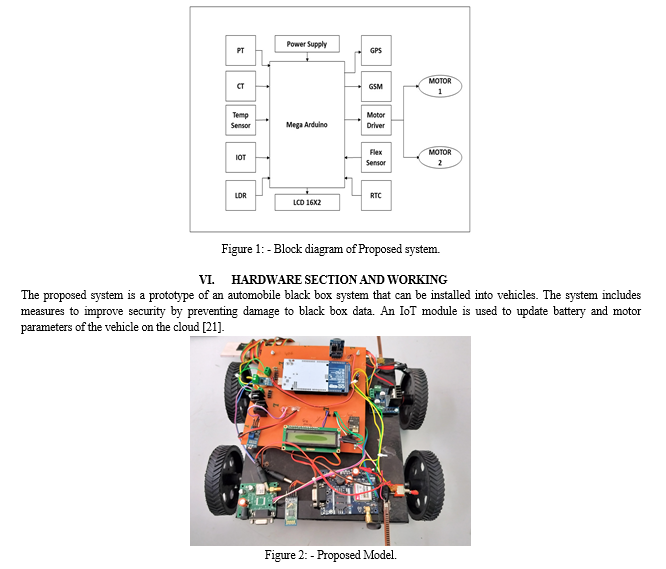
The black box provides information on the cause of accidents in remote areas, such as hill stations, and can inform nearby hospitals, traffic control, or ambulance of the accident location.
The transmitter side of the system uses GSM to send relevant alert messages to nearby safety sources, and sensors are included for safety purposes. The LCD display is used to show the stored data. The black box, which includes basic data recording features, is useful for electric vehicles and also includes advanced web tracking features that can be accessed from anywhere.
The system uses an Arduino (ATmega2560) microcontroller as the "brain" of the system, as it stores the program instructions. Temperature, flex, LDR, CT, and PT sensors are used to monitor vehicle status, as well as voltage, current, and temperature of the motor and battery. The GSM module is used to inform relatives and nearby ambulances. All data is updated to the cloud, allowing for remote control or monitoring using IoT technology [12].
A. Working
- Hardware Setup
The hardware setup includes the following components: -
a. GSM module for communication.
b. GPS module for detecting the accident location.
c. Flex sensor to determine the side of the accident.
d. Arduino Mega for central monitoring and control system.
e. Motor driver for controlling the speed and direction of the motor.
f. Temperature sensor to monitor the temperature of the motor and battery.
g. IoT module for storing data on the cloud.
h. LDR to detect the upper light of the vehicle.
i. RTC for tracking the travel distance of the vehicle.
j. CT for measuring the current of the motor and battery.
k. PT for measuring the voltage of the motor and battery.
2. LCD Initialization: Upon vehicle startup, all battery and motor parameters are displayed on the LCD.
3. Accident Detection: In the event of a sudden accident occurring on the front or back side of the vehicle, the flex sensor will bend, indicating the incident on the LCD display. Additionally, an SMS will be immediately sent to relatives to request emergency services.
4. Data Storage: To address the issue of data loss in case of EV fire incidents, data is stored on the cloud. The IOT ESP8266 module is utilized for this purpose.
5. Controlling of EV: The temperature sensor senses the temperature of motor and give signal to the Arduino through the motor driver to control speed of motor. If temperature of motor is greater than the curie temperature the magnet in DC motor is demagnetize.
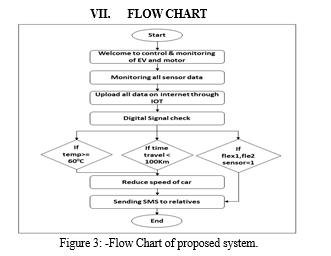
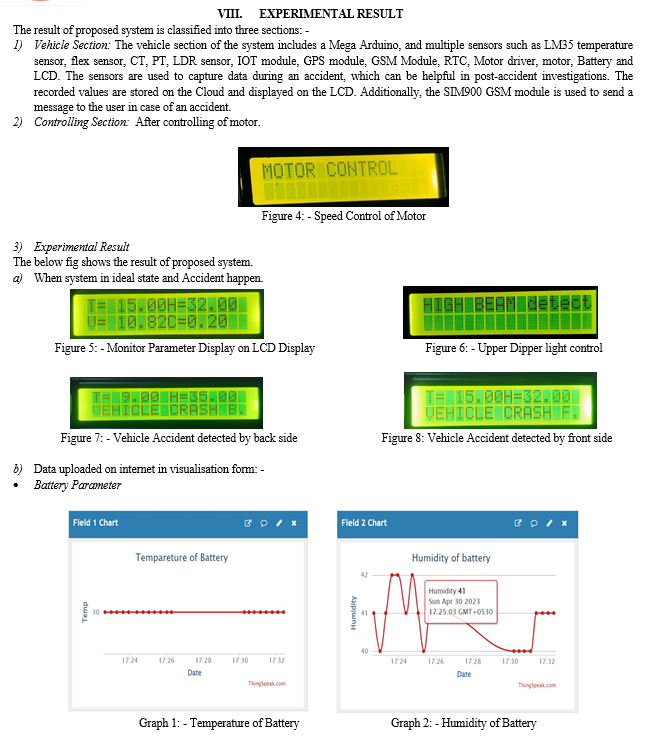
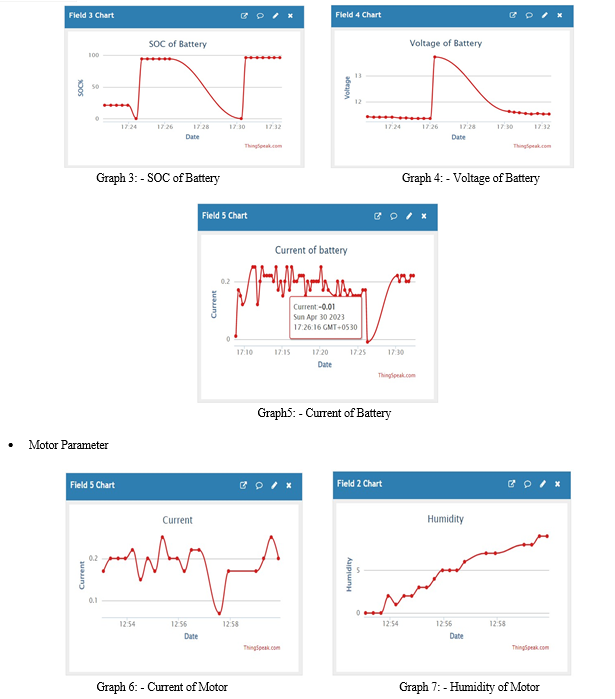
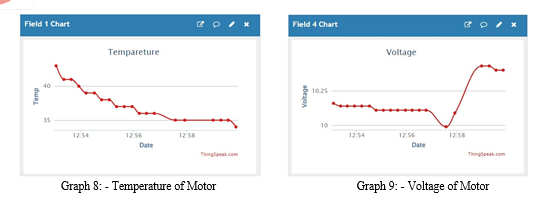
IX. ACKNOWLEDGEMENT
The authors would like to acknowledge the support of Amrutvahini college of Engineering and the valuable references provided. Any opinions, findings, and recommendations expressed in this material are solely those of the authors and do not necessarily reflect the views of others. The authors also express their gratitude to the faculty of Electrical Engineering department for their cooperation and support. Additionally, the authors would like to thank their parents for their continued support. Finally, the authors express their appreciation to their friends for their cooperation and encouragement.
Conclusion
The CONTROL AND MONITORING OF ELECTRICAL VEHICLE AND MOTOR system was successfully implemented, comprising an Arduino-Mega board, GPS Module, GSM Module, various sensors, and IoT module. The system is designed to be user-friendly. Furthermore, the project has achieved its objectives, which are as follows: 1) Determining the precise location of accidents. 2) Transmitting data to the internet via the IoT module. 3) Monitoring and controlling the motor in the event of a temperature increase. 4) Regulating the Upper (High Beam) Dipper light of the electric vehicle. 5) Providing emergency services to accident areas.
References
[1] Mathew et al. IoT-Based Battery Monitoring System for Electric Vehicle January 2018 International Journal of Engineering & Technology 7(4.31):505-510 DOI:10.14419/ijet. v7i4.31.25472 [2] Plett, G. L. (2004). Battery management systems for large lithium-ion battery packs. IEEE Transactions on Industrial Electronics, 51(1), 296-302. DOI: 10.1109/TIE.2004.840281. [3] Haque, M. H., & Mahmud, M. A. (2020). A review on power electronics converter topologies for electric vehicle applications. SN Applied Sciences, 2(7), 1-21. DOI: 10.1007/s42452-020-02927-9 [4] Lee, H., Kim, H., Lee, S., & Lim, H. (2019). Sensor-based state of charge estimation of lithium-ion batteries using machine learning. Energies, 12(20), 3957. DOI: 10.3390/en12203957 [5] Wang, L., & Chen, C. L. (2018). Cybersecurity of connected electric vehicles: Threats, vulnerabilities, and challenges. IEEE Transactions on Intelligent Transportation Systems, 19(8), 2470-2486. DOI: 10.1109/TITS.2018.2792292. [6] L. Arnedo, R. Burgos, D. Boroyevich, and F. Wang, ``System-level Blackbox DC-to-DC converter models,\'\' in Proc. IEEE Appl. Power Electron. Conf. Expo., Feb. 2009, pp. 1476_1481. [7] B. Lunz and D. Sauer, ``Electric Road vehicle battery charging systems and infrastructure,\'\' in Advances in Battery Technologies for Electric Vehicles, B. Scrosati, J. Garche, and W. Tillmetz, Eds. Chicago, IN, USA: Woodhead, 2015, pp. 445_467. [8] O. Kolawole and I. Al-Anbagi, ``Electric vehicles battery wear cost optimization for frequency regulation support,\'\' IEEE Access, vol. 7, pp. 130388_130398, 2019. [9] G. Guarderas, A. Frances, D. Ramirez, R. Asensi, and J. Uceda, ``Blackbox large-signal modeling of grid-connected DC-AC electronic power converters,\'\' Energies, vol. 12, no. 6, p. 989, Mar. 2019, doi: 10.3390/en12060989. [10] Abdallah Kassem, Rabih Jabr, GhadySalamouni, Ziad KhairallahMaalouf, “Vehicle Black Box System”, Proceedings of the 2nd Annual IEEE System Conference, IEEE 2008, pp. 1-6. [11] Milind Khanapurkar, Dr.Preeti Bajaj, Dakshata Gharode, “A Design Approach for Intelligent Vehicle Black Box System with Intra-vehicular communication using LIN/Flex-ray Protocols”, Proceedings of 2008 IEEE International Conference on Industrial Technology IEEE 2008, pp. 1 – 6. [12] Watthanawisuth, N., Lomas, T., and Tuantranont, A., “Wireless Black Box Using MEMS Accelerometer and GPS Tracking for Accidental Monitoring of Vehicles”, Proceedings of IEEE-EMBS International Conference on Biomedical and Health Informatics (BHI), IEEE 2012, pp. 847 – 850. [13] Narkar, T. V. (2016). Automatic dipper light control for vehicles. International Journal of Research in Engineering and Technology, 5(3), 97-101. [14] Ms. Priyanka Dubal, Mr. Nanaware J.D, ?Design of Adaptive Headlights for Automobiles? International Journal on Recent and Innovation Trends in Computing and Communication, Volume: 3 Issue: 3, pp 1599-1603, March 2015. [15] Kabalci, Y.; Kabalci, E.; Padmanaban, S.; Holm-Nielsen, J.B.; Blaabjerg, F. Internet of things applications as energy internet in smart grids and smart environments. Electronics 2019, 8, 972. [16] Yao, L.; Chen, Y.Q.; Lim, W.H. Internet of Things for Electric Vehicle: An Improved Decentralized Charging Scheme. In Proceedings of the 2015 IEEE International Conference on Data Science and Data Intensive Systems, Sydney, Australia, 11–13 December 2015; pp. 651–658. [17] Sousa, R.A.; Melendez, A.A.N.; Monteiro, V.; Afonso, J.L.; Ferreira, J.C.; Afonso, J.A. Development of an IoT system with smart charging current control for electric vehicles. In Proceedings of the IECON 2018-44th Annual Conference of the IEEE Industrial Electronics Society, Washington, DC, USA, 21–23 October 2018; pp. 4662–4667. [18] Muralikrishnan.R, “Automatic Headlight Dimmer A Prototype for Vehicles”, International Journal of Research in Engineering and Technology, Vol.3, Issue: 02, Feb-2014, pp. 85-90. [19] Mrs. Smita Desai, Vice-Principal Bharatesh College of Computer Applications Belagavi, Karnataka, Miss. Shreya Desai Electronics and Communication, Gogte Institute of Technology, Belagavi, Karnataka, “Smart vehicle automation,” IJCSMC, Vol. 6, Issue. 9, September 2017. [20] Ruhi Kiran Bajaj 1, Madhuri Rao 2, Himanshu Agrawal 3, “Internet of Things (IoT) In The Smart Automotive Sector: A Review,” J IOSR Journal of Computer Engineering (IOSR-JCE) e-ISSN: 2278-0661, p-ISSN: 2278-8727, PP 36-44. [21] G. Hayes, F. Blosser, “Motor Vehicle Crashes Claim More than a Million Lives Worldwide”, CDC Injury Center Media Relations, Press Release, April, 2004. [22] https://thingspeak.com/login?skipSSOCheck=true. [23] https://www.amazon.in/s?k=arduino+mega+amazon&adgrpid=59207975216&ext_vrnc=hi&hvadid=294132147734&hvdev=c&hvlocphy=9300381&hvnetw=g&hvqmt=e&hvrand=10118991824217675842&hvtargid=kwd-383378943077&hydadcr=25653_1900982&tag=googinhydr1-21&ref=pd_sl_7cud2o29ng_e.
Copyright
Copyright © 2023 Dr. S. S. Kadlag, Shembade Shrikrushna, Udar Ashutosh, Sinare Rohan, Phapale Akshay. This is an open access article distributed under the Creative Commons Attribution License, which permits unrestricted use, distribution, and reproduction in any medium, provided the original work is properly cited.

Download Paper
Paper Id : IJRASET52495
Publish Date : 2023-05-18
ISSN : 2321-9653
Publisher Name : IJRASET
DOI Link : Click Here
 Submit Paper Online
Submit Paper Online

